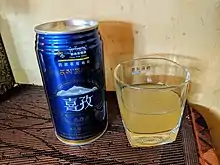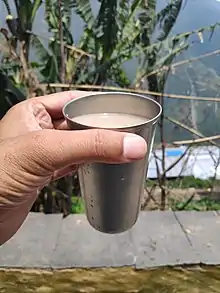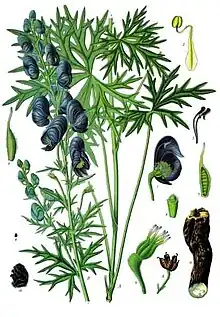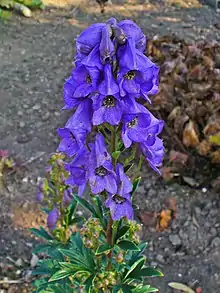.jpg.webp) Nepalese chhaang brewed from rice | |
| Type | Rice beer |
|---|---|
| Region of origin | Nepal, Tibet |
| Ingredients | Rice |
Chhaang or chhyang (Tibetan: ཆང་, Wylie: chang, Nepali: छ्याङ, Newar: थो:) is a Nepalese and Tibetan alcoholic beverage also popular in parts of the eastern Himalayas, Yakkha, Limbu, Dura, Newar, Sunuwar, Rai, Gurung, Magar, Sherpa, Tamang and Lepcha communities. Among the Lepcha, it is called Chi.[1] It is also known as jaarh in Nepal.[2]
Geographical prevalence
Chhaang is consumed by the ethnically Tibetan, Ladakhi and Nepalese, and to a lesser degree, by the people of the neighboring nations of Pakistan and Bhutan. It is usually drunk at room temperature in summer, but is often served piping-hot in brass bowls or wooden mugs when the weather is colder. The Limbu people of eastern Nepal call the drink Tongba.[3][4]
Ingredients and drinking


Chhaang is a relative of beer. Barley, millet (finger-millet) or rice grains are used to brew the drink. Semi-fermented seeds of millet are served, stuffed in a barrel of bamboo called a dhungro. Boiling water is then poured in and sipped through a narrow-bore bamboo tube called a pipsing.
When the boiled barley has cooled, some yeast or dried barm is added and it is left to stand for two or three days after fermentation begins. This concoction is called glum. The barm consists of flour and, in Balti, often has ginger and aconite added to it.[5]: 341 After fermentation is complete, water is added to the brew and it is then ready for consumption.[6]
In Lahaul the glum is pressed out by hand instead of by filtering, yielding a rather cloudy drink. The residue of malt can be pressed through a strainer and then mixed with water or milk and used in baking bread or cakes.[5]: 154
Near Mount Everest of Nepal, chhaang is made by passing hot water through fermenting barley, and is then served in a large pot and drunk through a wooden straw.[7]
This beverage is similar to the traditional drink of the Limbus, mandokpenaa thee.[8]
Nepalese jand refers to the turbid liquor which is obtained by leaching out the extract with water from the fermented mash. Unlike chhang or tongba, jand is served in large mugs. These alcoholic beverages are generated using a traditional starter called murcha. Murcha itself is prepared by using yeast and mold flora of wild herbs in cereal flours.[9]
Aconite and potential toxicity


The plant name Aconite may refer to two plant genera in the family Ranunculaceae, namely Aconitum and Eranthis, although Eranthis is known more usually as Winter Aconite. The plants used in the brewing of Chhaang in Baltistan and Ladakh are, however, almost certainly referable to Aconitum species - notably the local Aconitum ferox - which have a long history of use in the folk medicinal systems of Asia.[10][11] Aconitum species are amongst the most virulently poisonous plants known, containing a variety of extremely toxic alkaloids, including aconitine and pseudaconitine.
The use of Aconitum as an additive in beer-brewing is therefore a practice fraught with the danger of fatal poisoning and should on no account be undertaken by any individual attempting to replicate a traditional Chhaang recipe. Although individual Aconitum species vary somewhat in the degree of their toxicity, all are poisonous and, when used in traditional herbal medicine, are invariably pre-treated in various ways intended to minimise their toxicity, while retaining their assumed therapeutic properties. Nevertheless, numerous fatalities have occurred resulting from such medicinal use e.g. in certain Chinese medicinal soups consumed for their supposed tonic effects, which include augmenting physical strength, boosting the immune system, and dispelling 'wind' and 'dampness'.[12]
Culture
Chhaang is said to be the best remedy to ward off the severe cold of the mountains. It reputedly has many healing properties for conditions like the common cold, fevers, allergic rhinitis, and alcoholism among others.
According to legend, chhaang is also popular with the Yeti, or Himalayan Snowmen, who often raid isolated mountain villages to drink it.[13]
Social correlates
Drinking and making offerings of chhaang are part of many pan-Tibetan social and religious occasions, including settling disputes, welcoming guests, and wooing.[14]
See also
- Alcohol in Nepal
- Raksi – Nepalese and Tibetan distilled alcoholic beverage.
- Tibetan beer
- Tongba
- List of Indian beverages
- List of Tibetan dishes
References
- ↑ "Chhang: The Beer of the Himalayas". Live History India. 28 May 2017. Archived from the original on 27 January 2021. Retrieved 19 September 2018.
- ↑ The Rough Guide to Nepal, Apa Publications (UK), 2018 ISBN 1786719975.
- ↑ Sarda, Kritika (28 May 2017). "Chhaang: The Beer of the Himalayas". LiveStoryIndia. Archived from the original on 27 January 2021. Retrieved 19 September 2018.
- ↑ Shashi Bala Singh (4 February 2010). "Chhang - A barley based alcoholic beverage of Ladakh, India". Indian Journal of Traditional Knowledge. 11 (1): 190–193.
- 1 2 Jaschke, H. Ä. A Tibetan-English Dictionary. (1881). Reprint: (1987). Motilal Banarsidass, Delhi. ISBN 81-208-0321-3.
- ↑ Das, Sarat Chandra. (1902). Lhasa and Central Tibet, p. 23 and note. Reprint: (1988). Mehra Offset Press, Delhi.
- ↑ Mayhew, Bradley and Kohn, Michael. (2005) Tibet. 6th Edition, p. 75. ISBN 1-74059-523-8.
- ↑ P.75 Handbook of Plant-Based Fermented Food and Beverage Technology, Second Edition By Y. H. Hui, E. Özgül Evranuz CRC Press, 17 May 2012
- ↑ J. David Owens (Editor) Indigenous Fermented Foods of Southeast Asia (2014), p. 142, at Google Books
- ↑ Singhuber, Judith; Zhu, Ming; Prinz, Sonja; Kopp, Brigitte (29 October 2009). "Aconitum in Traditional Chinese Medicine—A valuable drug or an unpredictable risk?". Journal of Ethnopharmacology. Elsevier. 126 (1): 18–30. doi:10.1016/j.jep.2009.07.031. PMID 19651200. Retrieved 11 August 2020.
Aconitum species have been used in China as an essential drug in Traditional Chinese Medicine (TCM) for 2000 years.
- ↑ "Aconite (fu zi)". Acupuncture Today. Retrieved 11 August 2020.
- ↑ Chan, TY (2014). "Aconitum alkaloid poisoning related to the culinary uses of aconite roots". Toxins (Basel). 6 (9): 2605–11. doi:10.3390/toxins6092605. PMC 4179150. PMID 25184557.
- ↑ "Yeti: The Snow-Man". Travel Journey. Retrieved 2020-12-25.
- ↑ "Bhutanese". Retrieved 5 October 2014.